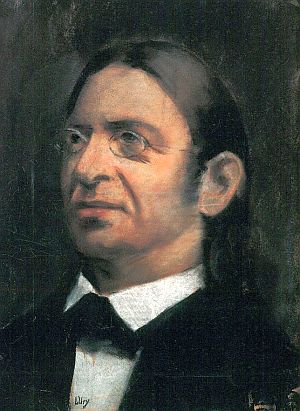Abraham Geiger (Abraham Geiger)

As a child, Abraham Geiger started doubting the traditional understanding of Judaism when his studies in classical history seemed to contradict the biblical claims of divine authority. At the age of seventeen, he began writing his first work, a comparison between the legal style of the Mishnah and Biblical and Talmudic law. He also worked on a dictionary of Mishnaic (Rabbinic) Hebrew. Geiger’s friends provided him with financial assistance which enabled him to attend the University in Heidelberg, to the great disappointment of his family. His main focus was centered on the areas of philology, Syriac, Hebrew, and classics, but he also attended lectures in Old Testament, philosophy, and archaeology. After one semester, he transferred to the University of Bonn, where he studied at the same time as Samson Raphael Hirsch. Hirsch initially formed a friendship with Geiger, and with him organized a society of Jewish students for the stated purpose of practicing homiletics, but with the deeper intention of bringing them closer to Jewish values. It was to this society that Geiger preached his first sermon (January 2, 1830). In later years he and Hirsch became bitter opponents as the leaders of two opposing Jewish movements.
At Bonn, Abraham Geiger began an intense study of Arabic and the Koran, winning a prize for his essay, written originally in Latin, and later published in German under the title “Was hat Mohammed aus dem Judenthume aufgenommen?” (“What did Mohammed take from Judaism?”). The essay earned Geiger a doctorate at the University of Marburg. It demonstrated that large parts of the Koran were taken from, or based on, rabbinic literature. (On this see Origin and development of the Qur’an). This book was Geiger’s first step in a much larger intellectual project. Geiger sought to demonstrate Judaism’s central influence on Christianity and Islam. He believed that neither movement possessed religious originality, but were simply a vehicle to transmit the Jewish monotheistic belief to the pagan world. At this time, no university professorships were available in Germany to Jews, so Geiger was forced to seek a position as rabbi. He found a position in the Jewish community of Wiesbaden (1832–1837). There he continued his academic publications primarily through the scholarly journals he founded and edited, including Wissenschaftliche Zeitschrift für jüdische Theologie (1835–39) and Jüdische Zeitschrift für Wissenschaft und Leben (1862–75). His journals became important vehicles in their day for publishing Jewish scholarship, chiefly historical and theological studies, as well as a discussion of contemporary events. By that time Abraham Geiger had begun his program of religious reforms, chiefly in the synagogue liturgy. For example, he abolished the prayers of mourning for the Temple, believing that since Jews were German citizens, such prayers would appear to be disloyal to the ruling power and could possibly spark anti-semitism. Geiger was the driving force in convening several synods of reform-minded Rabbis with the intention of formulating a program of progressive Judaism. However, unlike Samuel Holdheim, he did not want to create a separate community. Rather, his goal was to change Judaism from within.
Born
- May, 24, 1810
- Frankfurt am Main, Germany
Died
- October, 10, 1874
- Berlin, Germany
Cemetery
- Jüdischer Friedhof Prenzlauer Berg
- Berlin
- Germany


